#charcoal nazi
Explore tagged Tumblr posts
Text
Do you like to use the Mushroom Cloud as a fun Barbieheimer meme? If you do, it's fine so long as you know what the cloud caused and what it symbolizes. If you don't know the circumstances of the mushroom cloud, please search ''Hiroshima Nagasaki atomic bomb people (with your safe search off)' on Google Images. *The images are very disturbing. Please DO NOT try it if you are sensitive to extremely disturbing images.
I'm Japanese. In Japan, unfortunately, many people have never seen the old pictures of the real effects of the mushroom cloud. We learn about the atomic bombing of Hiroshima and Nagasaki (both are cities in Japan) in primary school or junior high, when we are about 10-14 years old. Many adults think it's too risky to show children the pictures because it shows human bodies, which look like human charcoal. Living people got severe burns on their faces, their backs, and their whole bodies looked like melting wax (additionally, most of the people in the pictures are citizens, not soldiers. There are many kids, babies, and old people, of course.) Even though it happened in our land, many people (including me, I'm ashamed to say though) don't feel it was an actual event because it seems very unreal and it happened almost 80 years ago. Fortunately, I had a chance to learn about the atomic bombing and see several pictures of it. Now I know what happened in 1945. I think some people here/outside of Japan realize it as well.
I don't blame people born outside of Japan who have never known/learned about the effects of the atomic bombing. I want to ask you to learn and understand what happened under that iconic mushroom cloud before you make a meme with it. If you think 'So what?' after that, I will have nothing more to say to you.
I've not seen Barbie or Oppenheimer because they are not released here yet. But I feel they are both very interesting. I'm looking forward to watching them. I wish I could have fun watching them without any distractions before going to the theatres.
Don't get me wrong. I know that during World War II the Japanese government did tons of terrible things to people outside and inside of Japan. I just want people to know that atomic bombing is a very serious issue, and using the images of the mushroom cloud as a meme/design is like using a symbol of the Nazi/KKK as a fun meme. It's not fun. Atomic bombing should never happen anywhere in the world.
#I'm NOT saying it to make Japanese people 'victims' of the memes#I'm afraid that people get used to making jokes about it#or forget how horrible nuclear weapons are#the atomic bomb in 1945 killed 129000-226000 people in total#at least 88% of those were civilians#the total number is uncertain#because in many cases there were no remains to be found
2K notes
·
View notes
Text

OKAY SOOO uhm ignore the shitty image bc i draw on my ipad instead of my phone but my version offf richtofen :D!!
okay so im keeping his name as edward richtofen bc im not that creative 😭
ANYWAY-
appearance wize his hair is a little more grown out yet not to long because he is older and his hair's thinning and isnt strong enough to be longer...also he has rubbed charcoal all over the nazi symbol on his arm due to his brain being half sidded (he sometimes escapes from his physco sociopathic brain and becomes an okay person and he didnt wanna have the symbol on him) i've made his uniform stained and bloody and added some extra scars and rips on his clothes dempsey also recently punched him in the nose so thats why hes bleeding :3 the others are coming up i think dempseys next then nikolai and takeo :3
ill most likely definitely add more stuff to him but its just a beta design soooo yee!^^
9 notes
·
View notes
Text

Miss Hunter / Barbara / Johnny, charcoal, 2023
Deborah Kerr plays three roles in the unconventional, heartfelt anti-Nazi film The Life and Death of Colonel Blimp: Miss Edith Hunter, Barbara Wynne, and Angela 'Johnny' Cannon. The three women she plays represent in some measure three generations of women, and she is one of the ideals pursued by Clive Candy, before his idealistic and gentlemanly worldview has to contend with the threat of a Nazi reality.
13 notes
·
View notes
Text
I think already that being a nazi is quite stupid but being a nazi spaniard is like ????
You have skin dark enough to prevent sunburns without sunscreen, brown eyes and hair charcoal black, the people you follow that have similar black sun tattoos think that you are less than a dog
0 notes
Text
OK this is so fucking stupid but I had to talk about after the number of purple who misused this term.
Cultural appropriation is NOT a black person dyeing their hair blond and straightening it. It's not doing something that other cultures normally have.
It's more like taking a single part of the culture and twisting it to whatever you want to do it and claiming it as part of your culture or disrespecting the practice in the process of isolating it from the whole culture and not understanding the cultural significance behind it.
Examples:
The swastika is the most famous one. It's an Indian symbol of prosperity and good luck but it was culturally appropriated by the Germans to represent nazis forever changing the meaning of it for the rest of the world. Now when people hang up the symbol in the house, foreigners will only think of the nazis.
Wearing traditional feather head dress from native Americans without context. I don't know much about it but I know that it's not exactly supposed by worn just by anyone at any time.
The use of the third eye on the atla series. This is one me and my family noticed while watching it and I still remember how uncomfortable it felt to watch. The third eye represents all seeing and to see the truth of the universe through spiritual practices like shiva, the first guru and the first to practice yoga did. There is exactly one story of him using it to burn someone with it. There is much deeper meaning and it was reduced to that one aspect and used trivially.
While we're at it, YOGA. I hope people know that if you don't do it properly, it will hurt you. I know it's become so widespread that almost any stretching is known as yoga but it not only changes ur body, it tampers with way ur body functions and the way you even breathe so please learn from someone who truly understands it and the culture it comes from, for your own health at the very least. The mudra that you hold (hand gesture shape whatever) is very important and has to be accurate or it can and will affect you badly. And for fucks sake stop calling it by common phrases like cobra pose or diamond pose and what not. Learn the actual thing, its not that hard. No, do not argue with the pronunciation, we've been corrected our whole life on foreign pronunciations, you can gather ur humility and learn to pronounce bhujangasana and vajrasana.
Any time someone says chicken tikka masala is a British dish. Or calls pappadam poppadoms or a British snack (even fucking autocorrect is telling me its poppadoms. Stfu autocorrect.). Or call Parathas stuffed flat bread. Or how about that time the university of Mississippi tried to patent turmeric. Tie and dye? More like Bandhani. Who do you think used salt and charcoal in toothpaste but companies said that was bad for health then later incorporated it themselves?
I can go on and on about it. I don't have many examples from other cultures as I'm not exposed to them but feel free to add on. No one is against other cultures appreciate and enjoy these aspects. What we're against is stealing it and calling it your own or twisting is original meaning and renaming it. Stop it. Use the original names.
What isn't cultural appropriation: wearing a sari or ghagra or any other cultural desi festival wear. You can! We would love to see it become more common place and accepted festival wear. On wearing a bindhi or pottu: from my view, you can absolutely as long as you are respectful and call it the correct name.
Making or eating desi food or desi inspired food? Give credits using the actual name! It's jalebi or jangari not sugar honey pretzels.
Do you have doubts as to something being cultural appropriation? Ask someone of that culture and be respectful! I think that's the main aspect of this: respect. Respect for the history and effort it takes to make it. Credits! Much like an artist or author likes to see credits for their work when you repost! If they say do not repost, you just don't!
Now go have fun! Culture is meant to be enjoyed.
0 notes
Text
On this day in Wikipedia: Sunday, 7th April
Welcome, vítejte, velkommen, მოგესალმებით (mogesalmebit) 🤗 What does @Wikipedia say about 7th April through the years 🏛️📜🗓️?

7th April 2023 🗓️ : Death - Ben Ferencz Ben Ferencz, American lawyer (b. 1920) "Benjamin Berell Ferencz (March 11, 1920 – April 7, 2023) was an American lawyer. He was an investigator of Nazi war crimes after World War II and the chief prosecutor for the United States Army at the Einsatzgruppen trial, one of the 12 subsequent Nuremberg trials held by US authorities at..."
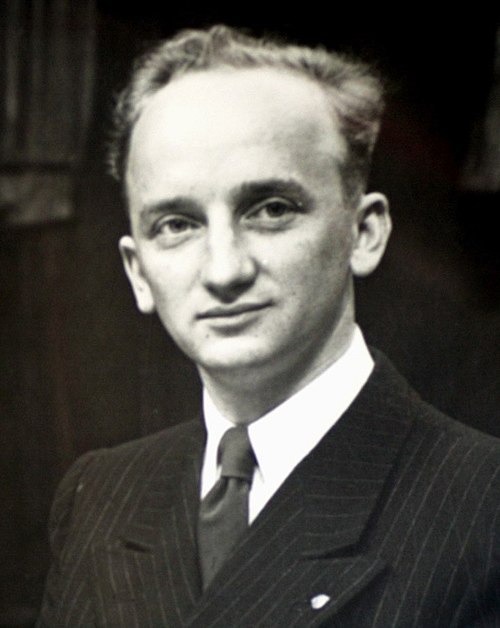
Image by
Prosecutor_Benjamin_Ferencz_at_the_Einsatzgruppen_Trial.jpg: US Army photographer on behalf of the OCCWC/IMT
derivative work: Minderbinder (talk)
7th April 2019 🗓️ : Death - Seymour Cassel Seymour Cassel, American actor (b. 1935) "Seymour Joseph Cassel (January 22, 1935 – April 7, 2019) was an American actor who appeared in over 200 films and television shows, with a career spanning over 50 years. He first came to prominence in the 1960s in the pioneering independent films of writer/director John Cassavetes. The first of..."

Image licensed under CC BY 2.0? by sagindie from Hollywood, USA
7th April 2014 🗓️ : Death - George Dureau George Dureau, American painter and photographer (b. 1930) "George Valentine Dureau (December 28, 1930 – April 7, 2014) was an American artist whose long career was most notable for charcoal sketches and black and white photography of poor white and black athletes, dwarfs, and amputees. Robert Mapplethorpe is said to have been inspired by Dureau's amputee..."
7th April 1973 🗓️ : Birth - Marco Delvecchio Marco Delvecchio, Italian footballer "Marco Delvecchio (Italian pronunciation: [ˈmarko delˈvɛkkjo]; born 7 April 1973) is an Italian retired professional footballer who played as a forward. Although he played for several Italian clubs throughout his career, he spent most of it at Roma, where he is still remembered by the club's fans..."

Image licensed under CC BY-SA 3.0? by Дмитрий Садовников
7th April 1924 🗓️ : Birth - Johannes Mario Simmel Johannes Mario Simmel, Austrian-English author and screenwriter (d. 2009) "Johannes Mario Simmel (7 April 1924 – 1 January 2009), also known as J. M. Simmel, was an Austrian writer. He was born in Vienna and grew up in Austria and England. He was trained as a chemical engineer and worked in research from 1943 to the end of World War II. After the end of the war, he worked..."
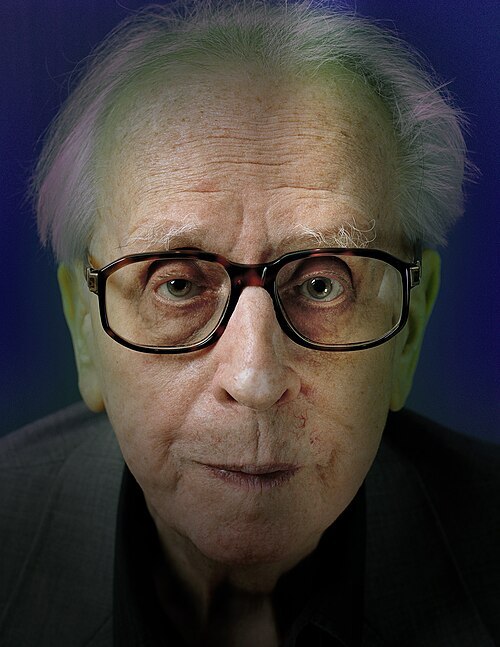
Image licensed under CC BY-SA 4.0?
7th April 1824 🗓️ : Event - Mechanics' institute The Mechanics' Institution is established in Manchester, England at the Bridgewater Arms hotel, as part of a national movement for the education of working men. The institute is the precursor to three Universities in the city: the University of Manchester, UMIST and the Metropolitan University of Manchester (MMU). "Mechanics' institutes, also known as mechanics' institutions, sometimes simply known as institutes, and also called schools of arts (especially in the Australian colonies), were educational establishments originally formed to provide adult education, particularly in technical subjects, to working..."
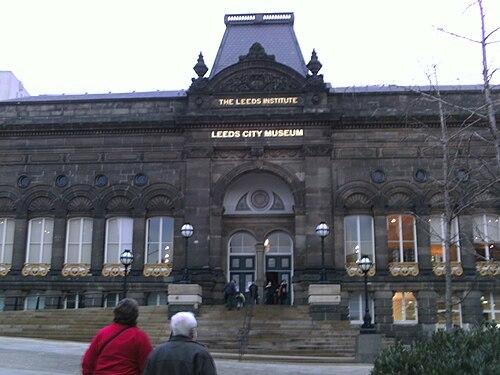
Image licensed under CC BY 3.0? by Mtaylor848
7th April 🗓️ : Holiday - Christian feast days: Blessed Notker the Stammerer "Notker the Stammerer (c. 840 – 6 April 912), Notker Balbulus, or simply Notker, was a Benedictine monk at the Abbey of Saint Gall active as a composer, poet and scholar. Described as "a significant figure in the Western Church", Notker made substantial contributions to both the music and literature..."

Image by
Unknown authorUnknown author
0 notes
Text
More about Oskar Fischinger

Oskar Fischinger was born on the summer solstice in 1900 in Gelnhausen, Germany. He originally chose music as a career, studying violin and organ building (which attracted him because it combined precise knowledge of technical processes with mathematical harmonic theory) before 1914. Too young and unhealthy for war duty, he was trained in drafting, tool design, and engineering. Around 1920 in Frankfurt, he met Dr. Bernhard Diebold at a literary club. Seeing Fischinger's abstract scroll sketches, Diebold urged Oskar to take up abstract filmmaking. In April 1921, Fischinger was thrilled by the first performance of Walther Ruttmann's Lichtspiel Opus 1 (an abstract film with a live musical score) and vowed to devote himself to absolute cinema, which could best combine his skills in music and graphic art. He resigned his engineer's job and moved to Munich to become a full-time filmmaker. His first film experiments, made in the early 1920s, are among his most radical. In Wax Experiments and Spirals Fischinger designed visual patterns of extreme complexity which often develop in overlapping cycles, yet he interrupts these patterns with radical editing of single frames of contrasting imagery. Among Fischinger's form-breaking experiments of the era were the abstract multiple-projector performances (under the concept name of Raumlichtmusik or Raumlichtkunst with individual performances named Fieber, and Macht (and possibly other names). These were performed c. 1926-1927 using up to five film projectors and several slide projectors.

Early in his film-making career, Fischinger established a pattern of alternating commercial work with personal, experimental film-making. While it seems clear that he preferred working in an avant-garde way, commercial work afforded both income and access to the most advanced technology, and Oskar was, among all of the radical film-makers of the Twenties, the most technically knowledgeable and adventurous. Oskar supported himself during this period by making conventional animation, which demonstrates his mastery of realistic anatomy, perspective, and conventional story-telling. But his personal film Spiritual Constructions shows the same radical consciousness and experimental techniques as his abstract films: the slender tale of two drunks who argue and stagger home becomes an epic voyage of warping shapes and thwarted perceptions.
During the summer of 1927 he walked from Munich to Berlin, recording his journey in single-frame exposures - a premonition of the diary films two generations later. He was hired to make special effects of rockets, starscapes and planet surfaces for Fritz Lang's 1929 science-fiction feature Woman in the Moon. When he broke his ankle on the set, he began drawing animations on white paper in charcoal while recuperating, which led to his remarkable series of Studies, comprised of 14 short black-and-white film experiments tightly synchronized to music. A few of the later Studies were drawn by his brother Hans, most likely under Oskar's supervision.
In each of the Studies he set out to solve a different visual problem: in Studie Nr. 6, a flexible aerodynamic movement; in Studie Nr. 7 a deep-space perspective of hard-edged figures contrasted with a flat surface where sensuous art-nouveau shapes metamorphose; in StudieNr. 8 an orchestral multiplicity and density of figures, etc. These Studies screened widely in Europe, Japan and America, and created such demand that by 1932, Fischinger's studio had grown to include his brother Hans, Elfriede (who became his wife in 1933), and three other women. At this time, Fischinger was also pursuing a series of film experiments with drawn synthetic sound (Ornament Sound Experiments).
The close synchronization of the Studies with music (originally begun as ads for recordings, thus direct precursors of the music video) made them immensely popular with audiences worldwide, but after the advent of the Nazi regime, abstract works were classed as degenerate art, and it became more difficult to make any further experimental films.
Fischinger was involved with the development of the three-strip GasparColor film process, a European rival to Technicolor. With his technical training and exceptional understanding of the fundamental processes of cinema, Oskar was one of the very few who mastered this difficult process. The use of three-color film was relatively new in the cinema in the early Thirties, and while in Europe it was still not possible to use three-color film on an entire feature, GasparColor did lend itself to short films that did not require a realistic image. Although "experimentation" was still proscribed, color opened up new venues for Fischinger's animated and abstract works in the field of commercial advertisement - a media-hungry world that thrived on sensation and novelty. Fischinger's 1933-34 film Kreise (Circles) was cleared as an advertising film, but it is essentially abstract imagery, and the ad text only appears in the last few frames. Fischinger then created an animated color advertising film, Muratti Greift Ein (Muratti Marches On), and another color film, Composition in Blue, using small geometrical models. He exhibited the Composition at foreign festivals. The critical and popular success of Muratti Marches On and Composition in Blue attracted a great deal of attention, and Paramount offered Oskar work in America.
Paramount brought Fischinger to Hollywood in February 1936, but did not allow him to continue his work in color film, and his tenure at the studio was short. A grant from The Museum of Non-Objective Painting (Guggenheim Foundation) allowed him to buy his short film Allegretto back from Paramount, and in 1943 he was able to complete it in color as he had originally intended. Fischinger used a cel-layering technique to animate formal visual equivalents of the musical concepts of rhythm, harmony and counterpoint. He implemented a "divisionist" technique of changing colors from frame to frame in order to achieve particularly luminous and chromatic hues that could not be produced by normal methods of animation photography. The film was shown at museums and centers of advanced art all over the world, and Allegretto (1936-43) eventually came to be recognized as one of the most accomplished pieces in the history of visual music.
Fischinger found it extremely difficult to work in studio situations, enduring episodes at Paramount (1936), MGM (1937), and Disney (1938-9). He composed An Optical Poem to Liszt's "Hungarian Rhapsody No. 2" for MGM. He designed the Bach "Toccata and Fugue" sequence for Disney's Fantasia, but quit because his designs were simplified and altered to be more representational. Hilla Rebay, curator of The Museum of Non-Objective Painting, supported Oskar's work during the difficult war years with several grants. Rebay commissioned him to synchronize a film with a Sousa march (to demonstrate loyalty to America; this film was An American March). Oskar then proposed a film without sound in order to demonstrate the artistic validity of non-objective imagery, but Rebay insisted that he make a film to Bach's "Brandenburg Concerto No. 3." While carrying out his commission for Rebay, Oskar discreetly composed the silent masterpiece Radio Dynamics.

Although The Museum of Non-Objective Painting specifically required a cel animation film, Fischinger made his Bach film as a radical documentation of the act of painting, exposing a single frame each time he made a brush stroke. The film parallels the structure of the Bach music without slavish synchronization, and rediscovers some of the playfulness inherent in Bach's sense of formal invention. Although Motion Painting No. 1 won the Grand Prix for Experimental Film at the Brussels International Experimental Film Competition in 1949, Fischinger never again received funding for one of his personal films (only a few ad films in the 1950s). He turned increasingly to oil painting as a creative outlet. During the last twenty years of his life, Fischinger worked on a few commercial projects, several unfinished film and multimedia projects, many unfinished animation drawings, and by the end of his life had completed a substantial body of graphic work including some eight hundred paintings. Oskar Fischinger died on January 31, 1967.
His films continue to be included in exhibitions at major museums and cultural institutions worldwide, recently at the Whitney Museum, New York; the Guggenheim Museum, NY; Centre Pompidou, Metz; Tate Modern, London; MoCA, Los Angeles; the Hirshhorn Museum, Washington DC; Reykjavik Art Museum; Barbican Centre, London; Lentos Kuntsmuseum, Linz; ICC Tokyo, Daelim Museum, Seoul, and many others internationally.
0 notes
Text
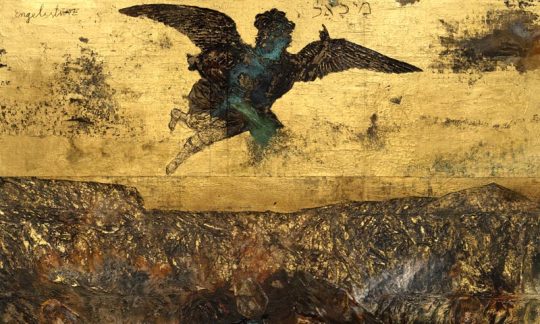
Anselm Kiefer: Fallen Angels
22 March - 21 July 2024, Palazzo Strozzi, Florence


Edwin Alexander Francis is the narrator of the audioguide produced by Orpheo Group / recorded at StudioColosseo, Rome


Anselm Kiefer, "Der Rhein" (woodcut collages on paper with oil, emulsion, acrilic and shellack mounted on canvas) (330 x 330cm) (1982-2013)

"Dem Unbekannten Maler" I (To the Unknown Painter I) (1982-2013) (oil and woodcut on paper on canvas) (190 x 330cm) ->

"Dem Unbekannten Maler" II (To The Unknown Painter II) (1982-2013) (oil and woodcut on board on canvas (280 x 330 cm) ->
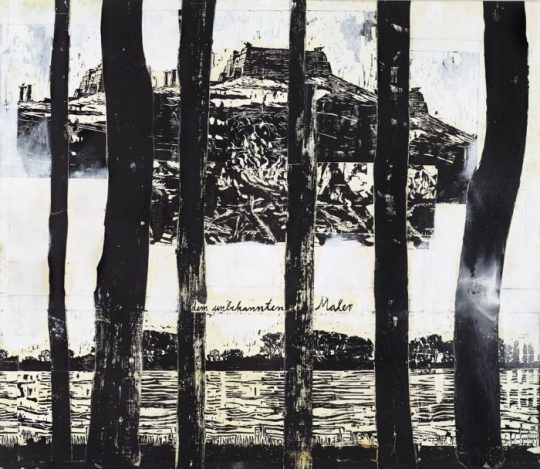
reference ->

<- "Dem Unbekannten Maler" (To the Unknown Painter) (1982)
"Hortus Philosophorum" (The Garden of the Philosophers) (1997-2011) (woodcut collages on paper with oil, emulsion, acrilic, shellack, gypsum and charcoal mounted on canvas) 580x 280cm ->

...and here's the audioguide track "Der Rhein" (The Rhine) – "Dem Unbekannten Maler" (To the Unknown Painter) – "Hortus Philosophorum" (The Garden of the Philosophers) ->
some curios: a series of photographs in his father's uniform called "Besetzungen" (Occupations) (1969) become "Heroische Sinnbilder" (Heroic Symbols) in 2009




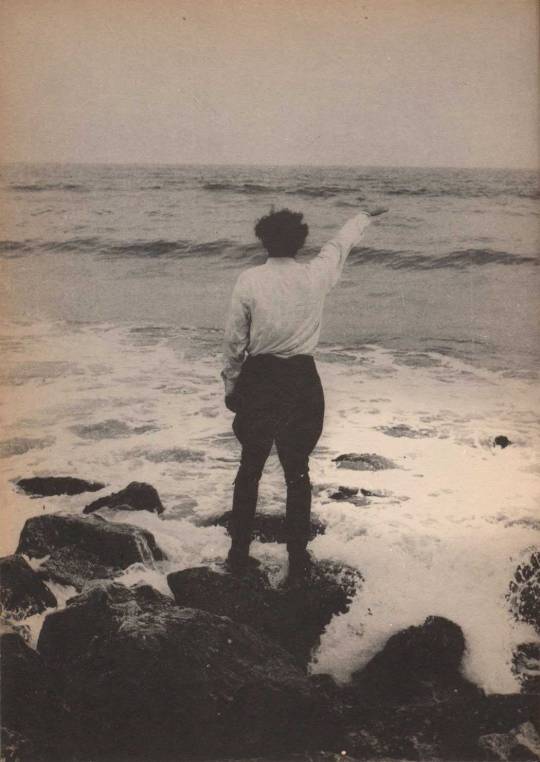
In the summer and autumn of 1969, then still a student at the Academy of Fine Arts, Kiefer took photographs of himself in various locations in Germany, Switzerland, France, Greece and Italy wearing the uniform of a German officer, his father, intentionally emulating the “victory salute” of Nazi rallies, a gesture prohibited in Germany during the process of denazification. He would call these actions Besetzungen (Occupations). These photographs, used over the decades by Kiefer in many different works with the title Heroische Sinnbilder (Heroic Symbols), were printed in large format in 2009, mounted on lead and then subjected to a process of electrolysis. Attached by a metal bar only at the upper end, they create the sensation of a fluctuating memory. …A deserted place surrounds the figure of the young artist, the silence is tangible and helps bring forth the memory of the atrocities committed by the National Socialist regime. Images taken at Sète, Montpellier and Paestum are presented here. Kiefer associated these works with three celebrated free verses by the hermit poet Salvatore Quasimodo: “We all stand alone on the heart of the earth / pierced by a ray of the sun's light / and suddenly it is night”. (“Ognuno sta solo sul cuor della terra / trafitto da un raggio di sole / ed è subito sera”
"Heroische Sinnbilder" (Heroic Symbols) (2009)




here's the "Heroic Symbols" clip from the audioguide (read by Edwin Alexander Francis) ->
....and here's the Green Button for (Anselm Kiefer's) in-depth consideration of the value of the photography, poetry and writing ->
click on the link below for all the info re the exhibition:
...and t h i s is very interesting, too, just as a reminder ->
...HERE'S THE US TRAILER ->
youtube
0 notes
Text
HEY!
I'm Michael!
I am a saxophone player, charcoal artist, long furby enthusiasts, and queen person
Exspect just random things from me like my hobbies such as...
Stardew Valley, Acnh, dark academia, punk and its ideals, diy's music, queer life, furbies, cooking, fish/reptiles, gardening
As well as just my daily life in the midwest
Dni: Racists
Neo Nazis
Homophobes and Transphobes
Or are hateful in any way
0 notes
Text
Oct 6. Blog Post 4
The Rohingya are an ethnic Muslim group who practice a variation of Sunni Islam. There is an estimated amount of 3.5 million Rohingya worldwide. Almost a third of Rohingya live in Myanmar, a country in Asia. Myanmar is a primarily Buddhist country.
The academic article I found is about the current genocide of the Rohingya going on in Myanmar. The article talks about how the Rohingya have been oppressed in Myanmar as far back as the 1940s. It was not even until 1990 that Rohingya people could even get limited rights to have similar rights to citizens, but still cannot get citizenship.
In 2017 a militant group known as the Arakan Rohingya Salvation Army, took responsibility for some attacks on Myanmar police. The Myanmar government declared the ARSA to be a terrorist group and mounted a violent campaign to stop them. This went farther than just getting rid of the ARSA. It started a complete genocide against the Rohingya.
Myanmar has been denying the genocidal intent of their actions. The UN keeps trying to step in with fail to end the genocide. They have raped, killed, destroyed the homes and villages of the Rohingya. Doing all sorts of unspeakable things and denying it.
This has forced the Rohingya to flee the country. They have fled to Bangladesh, Malaysia, India, and Indonesia. This just leads more to the proof that there is a genocide going on. The denial of Myanmar committing a genocide is absurd due to the amount of evidence of one.
This is what the main article I used was about. Looking into the article’s bibliography, I found another interesting article. This article is more about what the government is doing with the land and villages that they took from the Rohingya.
This article shows birds satellite photos of what the region of where the Rohingya lived six months after the genocide began. Images show plots of land completely black scattered with charcoal, of where villages used to be.
These images are quite horrifying because it is almost impossible to tell that something used to be there. The only sign of something is the fact that there is black charcoal all over. Its scary to think that the government is trying to erase the Rohingya people as a whole. Burning down all the villages and any signs that they once were there. When I first read this, I instantly was making connections to what the Nazi’s did in WW2.
Bibliography:
Main Article- “What Forces Are Fueling Myanmar’s Rohingya Crisis?” Council on Foreign Relations, Council on Foreign Relations, www.cfr.org/backgrounder/rohingya-crisis. Accessed 10 Oct. 2023.
Secondary Article- “Myanmar: Remaking Rakhine State.” Amnesty International, 1 June 2021, www.amnesty.org/en/documents/asa16/8018/2018/en/.
0 notes
Text

okay this is how this movie goes and why...its 1997 just because...
when i left nicole white "shade" apartment and forgot her stup id ass cuz o fwhat she did to my friend nicole laurie back in 1996 all raping her and shit anyway...that song, by underworld was out and shade took my briefs and wore them....and go tshit on them because she hates white people..she really does, shade does,..shes black as afro black ass charcoal...hate her guts, she moved to Germanhy cuz shes german nazi fascist cunt...anyway, because of that track by underworld ...and my name is munday and to her it sounds like...undlerwear...and she was always fucking with me and my white blood...she would call me Gilligans Island and stold carolines Anne Rice vampire book and made a deal about cameron liking the Sundays but worse, she raped my friend nicole laurie...so thats what happen ...one day i went over and jump the fence over at wehre shade white was staying at ...i had helped her out with rent and elelcricity bills and shit, she lived across dj whats his face apartment ....weird ass dude.said he was gay but pushed me over like a doll when i tried to hook up wiht him gay and shit...he aint gay, he child molester fucker anyway..i hate the dude...gots lots of stories about t hat mother fucker and has a bullet for his forehead with his name on it..... anyuway, ....so over at shade i found this white dude alll scarrre dbeing raped by that donald love or whatever all those nigger tweakers all fucking with my blood white brothers there and i told him lets fucking leave this shit hold dude and woollpoaper was with me , that s when i payed him to babysit me while i slept and help me out in 1997...anyway, shade wihte had that huge poster subway size trainspotting poster in that apartment and i wnat wanted to rip it offf the wall and take it with me....i fucking hate that kunt blak bitch trainspotting its not transgender or transecual its trainspotting its english and nothing to do with nigger obama gay marriage sicko black shit i love the movie anyway
#interesting now I have to rewatch this#nice to know it's not transecual I wasn't sure if I was going to be ok with it otherwise...
0 notes
Text
I replayed ME1 and ME2 back to back two years ago, something I've never done before (had ME1 on 360, ME2/3 on PC) and it really highlighted how gonzo twisted the perception of ME1 -> ME2 still is today. Everyone got mad at Ashley for being a horrid evil bitch who won't join your squad, pretending she was unreasonably mad about nothing, until you replay ME1 and pay attention to what Cerberus is up to and realize -- oh hey those guys are nazis. Those are human supremacists performing fucked up experiments on "race traitors", including sole survivor Shepard's previous squad. Those are actually the worst people in the galaxy. The worst people in the galaxy have rebuilt Shepard from a piece of charcoal and now borg-Shep is talking about how the nazis are actually cool with aliens and doing the right thing to save the galaxy. Nazi Cyborg Shepard is trying to convince Ashley that that there's really no need to worry about the nazis doing nazi things because their boss said he won't do any nazi things right now.
Gamers were so mad that a woman disagreed with them that they were more than happy to overlook that the woman was disagreeing with them over the ethics of being a space nazi because the space nazis have cool ships and big budgets. Gamers are STILL overlooking that Bioware made the batshit decision to force Shepard to join the space nazis and rewrote characters into braindead idiots to try and justify that decision when they could've MADE UP A NEW ORGANIZATION THAT WASN'T SPACE NAZIS.
Ashley would've been justified in putting a bullet between Shepard's eyes after finding out they were working for Cerberus, and I would thank her for her service.
The way I have to make sure I don’t get on Mass Effect tiktok because they ALWAYS end up hating on Ashley is so annoying. I swear people played the og Mass Effect once, killed Ashley during that play through and just never thought about her again besides miss remembering her comments.
How many times do I have to say it people. ‘I can’t tell the Aliens from the animals’ is triggered by being around Keepers. In universe there is a on going conversation about what the hell the keepers even are so while her comment is in poor taste she isn’t talking about any sentient being.
The ‘Bear Vs Dog’ monologue is a metaphor where humans are the dogs and the person is the Council. Her point is that the council would throw humans under the bus in a heartbeat and Oh, come ME3 she is completely right.
If you bring her along to the conversation with the  terra firma guy she makes it extremely clear that she doesn’t like them in anyway, even before she gets character development. She the hates her grandfather being used by them and strongly opposes them uses his history to promote their racist messages.
ALL the teammates in the og Mass Effect said dumb shit. Garrus in particular makes some shity comments. Because a group of random wildly different characters that start off distrusting each other but grow to love one another like family is a huge part of all the games.
But oh, Ashley is a woman so she gets to die while the boring soft boy gets to live.
#they could have also rewritten ME2 so it wasn't a completely meaningless waste of shepard's time#if you could play lotsb and arrival separately then you could basically skip ME2 entirely#but seriously what the FUCK why are people still mad about ashley for being self-conscious about her family's legacy#she did nothing wrong! ever! she's a great companion#mass effect
182 notes
·
View notes
Text
After the local government decided to build an observation tower atop a sandy hill on Wolin, an island in the Baltic Sea, a Polish archaeologist was called in to check the site before construction and look for buried artifacts from the spot’s macabre past.
Hangmen’s Hill, a public park, had in earlier times been an execution ground, a cemetery and, some believe, a place for human sacrifices — so who knew what grisly discoveries were in store?
But what the archaeologist, Wojciech Filipowiak, found when he started digging caused more excitement than distaste: charcoaled wood indicating the remains of a 10th-century stronghold that could help solve one of the great riddles of the Viking Age.
Was a fearsome fortress mentioned in ancient texts a literary fantasy or a historical reality?
It has long been known that Nordic warriors established outposts more than a millennium ago on Poland’s Baltic coast, enslaving indigenous Slavic peoples to supply a booming slave trade, as well trading in salt, amber and other commodities.
Not known, however, was the location of the Vikings’ biggest settlement in the area, a town and military stronghold that early 12th-century texts called Jomsborg and linked to a possibly mythical mercenary order known as Jomsvikings.
Some modern scholars believe that Jomsborg was never a real place, but instead a legend handed down and embroidered through the ages. The findings at Hangmen’s Hill on Wolin Island might alter that view.
“It is very exciting,” said Dr. Filipowiak, a scholar in Wolin with the archaeology and ethnology section of Poland’s Academy of Sciences. “It could solve a mystery going back more than 500 years: Where is Jomsborg?”
Interest in Vikings, once largely confined to a niche field of academic study, has surged in recent years as television series like “Game of Thrones,” movies, graphic novels and video games have embraced — and distorted — Norse themes, clothing and symbols. The Viking Age, or at least a rough approximation of it, has become a fixture of popular culture.
This has been good news for the tourism business in Wolin. “Vikings are sexy and attract a lot of interest,” said Ewa Grzybowska, the mayor of Wolin, which includes a town and a wider island district with same name.
But the mayor bemoaned that far fewer visitors come to her domain than to a nearby beach resort. She said more money was needed to carry out excavation work and develop Wolin as a world-class destination for Viking researchers and amateur enthusiasts.
Pointing out of her window in City Hall to a square that is believed to contain a treasure of unexcavated early medieval artifacts, she said: “Wherever you go here, there is a piece of history.”
That history, however, has often been a source of discord.
Nazi archaeologists scoured Wolin, which was part of Germany until 1945, for evidence of the presence of Vikings — and for proof of what the Nazis believed was the superiority of the Nordic race and its dominance in the early medieval period over local Slavic peoples, who later came to identify themselves as Poles and claimed the land for Poland.
When Poland took control of Wolin after World War II, Polish archaeologists hunted for artifacts that would enhance their country’s hold on former German lands and help reinforce a sense of national identity.
Schools in Wolin organized re-enactments of Viking invasions of Poland’s Baltic coast and, for decades after World War II, “far more kids wanted to be Slavs defending the island,” said Karolina Kokora, director of Wolin’s history museum.
That changed after Poland ditched communism and began turning West, away from Russia and its emphasis on Slavic pride. “After 1989, everyone wanted to be a Viking,” Ms. Kokora recalled.
Public fascination with Vikings has also led to a surge in historical sleuthing by amateurs.
Among them is Marek Kryda, a Polish American amateur historian and author of a polemical 2019 book that denounced Polish archaeology as a morass of ethnic chauvinism mostly blind to the role Vikings played in the early formation of Poland.
Mr. Kryda set off a storm of controversy last summer in Poland after he announced in The Daily Mail, a British tabloid, that he had located the likely grave of Harald Bluetooth, the historical Danish Viking king who once ruled in this area.
The consensus view among historians is that Harald probably died in the region at the end of the 10th century but had been buried in Denmark.
Mr. Marek said he had placed Harald’s likely burial mound in Wiejkowo, a tiny village inland from Wolin, by using satellite imaging. Dr. Filipowiak dismissed that as “pseudoscience.”
The furor over where Harald Bluetooth is buried has turned the Viking king — celebrated as a unifier of feuding Nordic fiefs and the inspiration for the name of a wireless technology designed to unite devices — into an agent of noisy division.
Ms. Grzybowska, the mayor, said she was not qualified to judge whether Harald was buried in her district but added that she would be delighted if true. “It would add special splendor and grandeur to our island,” she said.
Ms. Grzybowska’s district has a Slavs and Viking Village, dotted with thatched wooden huts and a stone inscribed with runes celebrating Harald Bluetooth. But these are modern fakes — representations of a distant Viking past that excites the imagination but has been hard to pin down with certainty despite the decades of digging by archaeologists looking for traces of Jomsborg.
Ms. Kokora, the museum director, described the elusive 10th-century settlement as a “medieval New York on the Baltic” — a trading entrepôt with a mixed population of Vikings, Germanic people and Slavs — that had mysteriously vanished from the map, leaving only whiffs of its existence in archaic texts.
It is said to have had thousands of inhabitants, a fortress and a long pier to accommodate the Viking ships that sailed to and from Scandinavia and as far as North America. Traces of enslaved Slavs traded along the Baltic coast in the first millennium have been found thousands of miles away in Morocco.
Sifting through shards of excavated pottery on a cluttered table in her museum, Ms. Kokora said the Vikings hadn’t bothered much with making pots and were not very good at it. “They just took from the Slavs,” she said.
In the 1930s, German archaeologists, eager to challenge Polish claims that the area had originally been settled mainly by Slavs, excavated a mound on the opposite side of town from Hangmen’s Hill in the hope of finding traces of Jomsborg — and proof that Scandinavians, an important pillar of the Nazi ideology of Aryan supremacy, had been there first. They found some artifacts but no evidence of a Viking stronghold.
Parts of Hangmen’s Hill had been excavated before Dr. Filipowiak started digging, but not the area selected for construction. The archaeologist said his serendipitous find of what he thinks could be the ramparts of 10th-century Jomsborg’s stronghold still needed more analysis, but he believes there is already “80 percent certainty” that this is the site.
The debate over Jomsborg’s location — or if it really existed — has been “a very long discussion,” Dr. Filipowiak said. “Hopefully, I can help end it.”
#history#military history#archaeology#racism#nazism#ww2#poland#norsemen#germany#nazi germany#denmark#jomsborg#harald bluetooth
0 notes
Text
UNDER A LEATHER JACKET
It's acceptable to stick to more comfortable ground if you're not convinced by the high-low mix (it's not for everyone). One of those low-key combinations that works well season after season and demonstrates to the world that you are knowledgeable about hoodie styling is a leather jacket and hoodie outfit. eric emanuel shorts sizing
"Hoodies have significantly improved in terms of quality and fit," claims Alex Field, head of menswear design at Reiss. Men want to invest in well-made, casual clothes that fit them well and can be worn in a variety of settings. Whether it be for a workout or as part of a chic off-duty ensemble. harry styles nazi shirt
Try out various colored hoodies underneath your outerwear and mix them with a pair of leather or suede Chelsea boots to smarten up this style. Use a black leather jacket and black or indigo jeans as the foundation. harry styles nazi merch
If you're going to adopt a "look" and establish yourself as a card-carrying member of Club Menswear, you should learn how to wear a sweatshirt with a suit or jacket. But that's no excuse for not trying out this high-low mix. essentials knit hoodie
Head of River Island's Style Studio Giles Farnham observes: 'Sure, a sweatshirt paired with a pair of straight-leg jeans and trainers is a tried and true combo that really works. But if you want to seem more professional, layer under an unstructured suit for a style that defies convention. eric emanuel sweatsuit
Try a mid-weight grey hoodie with a charcoal grey suit to pull off the sports-meets-suit style and go with white lace-up trainers instead of your typical business footwear to master hoodie fashion. playboi carti cat hoodie
Your best chance for a more relaxed approach to mixing smart and casual is a sweatshirt paired with a pair of business-casual jeans. Once more, it's a simple method to stay out of the dreaded overgrown teenage region. essential knit hoodie
The head of male design at ASOS, Nick Eley, advises pairing hoodies with long formal coats or wider-leg pants since 'high-low' clothing is becoming increasingly popular.
Choose a hoodie in a neutral colour, then match it with some pants and upscale athletic shoes to nail this style. Try a little pattern, like pinstripes or checks, on the bottom half if you're feeling daring. essentials hat
1 note
·
View note
Text
As Russia Creates New Radar-Absorbing Material, Who are the World Leaders in Stealth Tech?

Experiments in the use of special radar-absorbing materials and aerodynamic designs to provide combat aircraft with stealth characteristics go back to the Second World War. How are such aircraft defined? What are their advantages and drawbacks? And who is leading the charge in the development of next-gen stealth? Sputnik explores.
Engineers from a subsidiary of Russia’s Ruselectronics have created a new generation of stealth materials which the company says can absorb up to 95 percent of the electromagnetic radiation generated by radars.
The “fundamentally new material” is said to be capable of absorbing radio waves across a wide frequency range, and to consist of a fiberglass/metal core mixture that’s thin and lightweight enough to be used aboard aircraft components.
“The issue of creating a structural radar-absorbing material has long been a problem in the modern military aircraft industry. Existing aircraft stealth coatings need to be regularly restored, while fiberglass provides a reduced reflection coefficient which does not require maintenance. Our prototypes have already successfully passed required factory tests,” Central Design Bureau of Special Radiomaterials director Alexey Dymovskikh said in a press statement.
The company has been tasked with creating the stealth technology for engine compressor blades – typically one of the components most easily picked up by radar.
Ruselectronics promises the new radar-absorbing materials will “significantly complicate the detection of an aerial object using radar equipment,” thus improving the stealth characteristics of aircraft that use them.
What is Stealth and Why is It Necessary?
Aircraft designers use a variety of design tricks and technologies to reduce the likelihood of aerial vehicles being picked up by enemy radar systems. This includes creating aircraft with aerodynamic properties which reduce drag and visibility (known as "radar signature" or "radar cross-section") to radar signals, and a variety of radar-absorbent coatings ("radiation-absorbent materials," or RAMs). Other stealthy designs focus on reducing the area of the aircraft that can be picked up by radar, including components to shield compressor blades and engines, for example, or the use of a special fuel to reduce thermal radiation.
Stealth technologies have become a vital feature of many modern combat aircraft, as well as some drone and cruise missile designs, amid dramatic advances in detection, search and targeting radar technologies, as well as long-range surface-to-air missile designs, in the second half of the 20th century.
In their modern iteration during the Cold War, stealth technologies were envisioned by military planners as a futuristic tool to enter enemy airspace, carry out attacks on sensitive, strategic targets, and escape, hopefully without detection or interception by enemy defenses. However, the combat experience of US stealth aircraft in the 1990s showed that even against non-peer adversaries, stealth is not the end-all-be-all miracle weapon it was cracked up to be. More on that below.
When Was Stealth First Created?
The first "stealthy" aircraft go back to the Second World War, with Nazi Germany’s jet-powered flying wing designs such as the experimental Horten Ho 229 fighter/bomber, being perhaps the most famous example. German designers used experimental charcoal dust coatings on the airframe, and the aircraft’s itself featured a much sleeker radar cross section than its traditional, bulky twin-turboprop-engine cousins of the time.
The USSR and Britain also experimented with stealth technology, albeit in less glamorous fashion, before World War II broke out. These designs included the Soviet Polikarov Po-2 multi-role biplane, built almost entirely of fabric and wood, and the Yakovlev AIR-4 "Invisible Aircraft," a prototype of a plane built from cutting-edge synthetic polymers, aluminum powder paint, and lacquer work which allowed the plane to "disappear" from view in testing.
Britain’s de Havilland Mosquito light bomber was made mostly of wood, allowing it to evade early radar, and is arguably the most successful wartime "proto-stealth" design alongside the Po-2.

Soviet experimental 'Invisible Aircraft' prototype. 1930s. © Photo: Wikipedia/Lazzzer
Who Developed the First True Modern-Day Stealth Aircraft?
The advent of jet power and the increasing sophistication of radar and missile technology made the appearance of stealth fighter and bomber technology as we know it today a matter of time, with the British Avro Vulcan strategic bomber and the Lockheed SR-71 Blackbird strategic reconnaissance aircraft, created in the mid-1950s and mid-1960s, respectively, becoming the first aircraft with modern-day stealth elements produced in large numbers.
The SR-71 was used to effect during the Vietnam War, becoming the only American plane never to be shot down by North Vietnam’s air defenses. The aircraft was also used for spying operations against the Soviet Union in the Kola Peninsula and the Baltic Sea, and the Far East. During the 1973 Arab-Israeli War, Blackbirds provided the Israelis with timely intelligence about concentrations of Egyptian, Syrian, and Jordanian forces. The Blackbird was formally retired in the late 1990s, with enthusiasts citing political reasons and high operating costs, but the writing on the wall for the aircraft may have become clear following the fielding of the Mikoyan-Gurevich MiG-25, a Soviet supersonic interceptor whose speed and altitude characteristics made it possible to intercept the SR-71.

This United State Air Force SR-71 Blackbird spy plane nears the rear of a KC-135 stratotanker while in the process of being refueled somewhere over Nevada, Friday, Jan. 26, 1990. © AP Photo/Walt Zeboski/
The US and the USSR continued to experiment with stealth technology in the 1970s and early 1980s, with Rockwell rolling out the B-1 Lancer supersonic variable-sweep wing heavy bomber in the mid-1970s, and Lockheed building the Have Blue proof-of-concept stealth demonstrator in 1977. The Soviets followed up with the MiG-29 fighter, which included stealth features such as a radar-absorbing coatings and a frontal RCS of below one square meter. In the early 1980s, Tupolev created the Tu-160 "White Swan" variable-sweep wing heavy strategic bomber, which continues to hold records as one of the fastest and heaviest bombers ever created. While it was not designed specifically as a "radar-invisible" bomber, the Tu-160 features special radar-absorbent coatings, and, combined with its top speed of March 2.05, is designed to pop in and out of a combat zone and drop its ordinance before the adversary has a chance to respond.
In the mid-1980s, Lockheed began production of the F-117 Nighthawk, a contemporary flying wing-design developed as light stealth attack aircraft, and featuring an RCS of just 0.001 square meters. During the late 1980s, Northrop created its own flying wing stealth plane – the B-2 Spirit bomber –designed for bombing missions deep inside enemy territory. These two planes are touted as the first true "stealth" aircraft – where the technology is an integral, foundational part of the design, rather than a complementary add-on.

Serbs Downed an F-117 Stealth Jet. The Lockheed F-117 Nighthawk, "the Invisible", the pride of the US Air Force and a technological wonder, was shot down just three days after the bombing of the Federal Republic of Yugoslavia began — on 27 March 1999, near the village of Buđanovci; the aircraft became the only confirmed loss of a NATO stealth plane.
Modern stealth aircraft, and planes which incorporate stealth technologies, include the F-22 Raptor fighter, the Sukhoi Su-34 fighter-bomber, the MiG-35 and Su-35 fighters, the Eurofighter Typhoon, the HAL Tejas fighter, the Shenyang J-31 fighter, Sukhoi Su-57 fighter, and the F-35 Lightning II multirole aircraft.
What are the Vulnerabilities of Stealth Aircraft?


US Navy’s F-35 Stealth Fighters Seem to be Rusting on South China Sea Voyage! Top: Three F-35C Joint Strike Fighters on the USS Carl Vinson in the South China Sea on January 14, 2022. © Mass Communication Specialist Se Bottom: An F-35C Joint Strike Fighter on the USS Carl Vinson on January 10, 2022, showing rust-colored discoloration on its upper fuselage. © Mass Communication Specialist Seaman Larissa T. Dougherty
While they do have improved capability to operate in hostile aerial environments without detection compared to their non-stealth cousins, stealth aircraft are not invisible, and can be vulnerable to even legacy radar and missile systems –particularly when operating in a dense air defense environment, and if air defense troops display a high level of skill. In 1999, Yugoslav air defenses shot down a stealthy F-117 Nighthawk and hit another, with the first plane downed using the S-125 Neva, a Soviet air defense system first fielded in the early 1960s.

(Jan. 28, 2022) An F-35C Lightning II, assigned to the “Argonauts” of Strike Fighter Squadron (VFA) 147, recovers on the flight deck of Nimitz-class aircraft carrier USS Carl Vinson (CVN 70), Jan. 28, 2022. © Mass Communication Specialist 3r
Modern effective countermeasures to stealth aircraft include passive (multistatic) radar with improved RCS detection, infrared search and track systems, VHF radar, and over-the-horizon radar. Along with the US and some of its NATO allies, Russia, China, and Iran all boast the possession of modern radar and missile systems capable of detecting, tracking and if necessary downing enemy stealth aircraft. These include the Podsolnukh ("Sunflower"), a coastal over-the-horizon surface-wave radar system which can detect even the latest US stealth equipment – the F-35, at long-range.
— Morgan Artyukhina | Sunday March 02, 2023
0 notes
Text
A film about an opera written at a Nazi concentration camp on screen in Beverly
“The Kaiser of Atlantis” director Sebastián Alfie adapted charcoal sketches made by Terezín prisoners for the film’s animated sequences./COURTESY PHOTO By Shelley A. Sackett Argentine filmmaker Sebastián Alfie saw the opera, “The Kaiser of Atlantis,” by chance. He was visiting his hometown Buenos Aires in 2006, and happened to get tickets to the Teatro Colón, where it was playing. He was amazed…

View On WordPress
0 notes